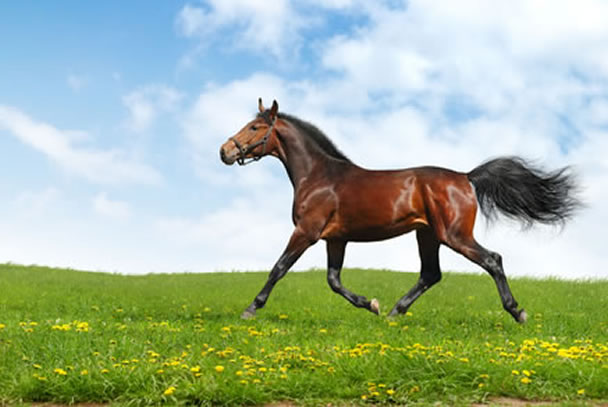Gaits of the Horse

The gaits of a horse refer to the way the horse moves across the ground. Humans, at least in their bipedal form, have only two gaits, the walk and the run. Both these gaits are two beat, the main difference being the run has a moment of suspension where the person is airborne, whereas the walk has a foot on the ground at all times.
The majority of horses in the world have four natural gaits: the walk, the trot, the canter and the gallop (some would classify the gallop as a fast canter, but because the sequence of footfalls goes from 3 to 4 beat, many consider it a separate gait). There are other gaits beyond these four that are a result of special training or specific breeding.
The Walk
The walk, the simplest and easiest to recognize of the gaits, is a four beat gait. By four beat we mean that each foot hits the round in succession. If one were to listen to the horse walking on a hard surface, for instance concrete, you would hear a distinct 1-2-3-4 pattern as the horse walked. When a horse walks one foot is lifted off the ground at a time, the other three remaining on the ground. The sequence of the footfalls is left front, right hind, right front, left hind.
The Trot
The trot is a two beat gait where the legs are moved in diagonal pairs, i.e. the left fore and right hind are off the ground and moving while the right fore and left hind remain on the ground. There is then a moment of suspension where all four legs are momentarily off the ground. Then the left fore and right hind hit the ground while the other pair is airborne. There is a distinct two beat sound when the horse trots as each diagonal pair hits the ground, giving the trot the 1-2, 1-2, 1-2 sound for which it is known.
The Canter
The canter (sometimes referred to as the lope) is a three beat gait, marked by its bouncing motion. The canter is also distinct from the walk and trot in that it is an asymmetrical gait, meaning it can be executed either to the left or the right (generally referred to as left lead or right lead). When a horse is cantering to the left, it means he is leading with his left fore, and one can visibly notice the horse reaching out with the left fore. The footfalls are as follows: the horse strikes off on the right hind and lifts the other three legs off the ground, the right is at that point supporting the weight of the horse. Then the left hind and right fore hit the ground together. This is then followed by the left fore hitting the ground, while the other three legs are airborne. There is then a moment of suspension after the left fore comes under the horse and all four legs are off the ground.
For the canter to the right, the footfalls are the opposite: left hind, the right hind and left fore together, followed by the right fore and then the moment of suspension.
The Gallop
As the canter speeds up and gets faster, there is a separation of the diagonal pair of legs in the second footfall. For example, as the right lead canter speeds up, the right hind and left fore no longer hit the ground at exactly at the same time and the beat becomes four beat.
Other Gaits and Sub-Gaits
Just like in humans where we have sub-gaits within gaits (i.e. marching, power walking etc., as sub-gaits of the walk), there are sub-gaits in the horse world. The walk, trot and canter can all be performed as Working, Medium, Collected and Extended gaits.
Besides the four natural gaits, there are also some other gaits, including the Pace, the Tolt, the Rack, and the Running Walk, that are a result of special training or are associated with certain breeds of horses and selective breeding.
Add your comments
comments powered by Disqus
